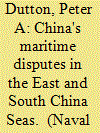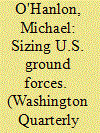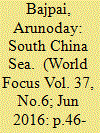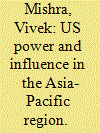| Srl | Item |
| 1 |
ID:
133060


|
|
|
|
|
| Publication |
2014.
|
| Summary/Abstract |
China pursues its security through interior strategies that involve the development of rings of security around central areas of national interest. The Chinese have long felt vulnerable from the sea, and their current maritime strategy seeks to reduce that vulnerability by extending a ring of maritime control around China's periphery. China pursues this control through a combination of forcestructure development and legal assertions. Tensions arise because China's strategy conflicts with the territorial claims, resource interests, and security concerns of other states in East Asia. China's strategy also causes friction with the United States, which relies on freedom of navigation in maritime East Asia for American security interests and which must reassure regional allies and partners that American security guarantees are meaningful. In order to ensure the position of the United States in East Asia, American policies must focus on maintaining the region as an open, maritime system. This requires continuous development of technological advantages to ensure that the center of power in Asia does not migrate from the maritime domain to the continent. It also requires the United States to support the ability of allies, friends, and partners to resist China's nonmilitarized coercion, as well as to reinforce the normative structure that supports the efficacy of maritime power in the region and around the globe.
|
|
|
|
|
|
|
|
|
|
|
|
|
|
|
|
| 2 |
ID:
133782


|
|
|
|
|
| Publication |
2014.
|
| Summary/Abstract |
During the Cold War, the United States varied between a "1 ½ war" and a "2 ½ war" framework for sizing its main combat forces. This framework prepared forces for one or two large wars, and then a smaller "half-war." Capacity for a major conflict in Europe, against the Soviet Union and its Warsaw Pact allies, represented the enduring big war potential. This period saw simultaneous conflict against China as a second possible big war, until Nixon's Guam doctrine placed a greater burden on regional allies rather than U.S. forces to address such a specter, and until his subsequent opening to the PRC made such a war seem less likely in any event. The half-wars were seen as relatively more modest but still quite significant operations such as in Korea or Vietnam.
|
|
|
|
|
|
|
|
|
|
|
|
|
|
|
|
| 3 |
ID:
145362


|
|
|
|
|
| Summary/Abstract |
The South China Sea seems to be heading towards a new flash point of conflict between China and the US and her regional allies. The fundamental reasons for the recent tensions are rising and assertive China with her persistent power projection, countermoves of the US under 'Asia Rebalancing' with the help of her regional allies' and lack of consensus on a new regional security architecture among regional players, China and the US. The US continues to be the resident power in this region since the World War II. The rise of China has unsettled the prevailing security regime in the Asia-Pacific region.
|
|
|
|
|
|
|
|
|
|
|
|
|
|
|
|
| 4 |
ID:
126828


|
|
|
|
|
| Publication |
2011.
|
| Summary/Abstract |
From 2002 through 2008, a network of at least 171 United States tax-exempt organizations (116 private foundations and 55 public benefit "charities") raised over $236.6 million to support the settlement enterprise. The amount spent during that period increased each year, going from $21.6 million in 2002 to more than $40 million in 2008, the last year that complete data is available.
|
|
|
|
|
|
|
|
|
|
|
|
|
|
|
|
| 5 |
ID:
144559


|
|
|
|
|
| Summary/Abstract |
Recently, the nature of the presence of the US in the Asia-Pacific has undergone significant changes. At least three developments—the rise of an economically and militarily resurgent China, a renewed counter-strategic approach by the US to rebalance its engagements with its close regional allies like Japan, the Philippines, South Korea and Australia, and the US’ efforts to expand and extend strategic cooperation with India and Vietnam—show that there are new emerging differences between the US and its four major non-NATO allies in the Asia-Pacific. These developments point towards declining strategic reciprocity of these nation states with the US and vice versa as they seek relative autonomy in their engagements with Beijing along with other extra-regional powers. While this has tacitly mandated the expansion of the US alliance system from the core Asia-Pacific region westwards to include the Indo-Pacific, the Indian Ocean and a few other Southeast Asian nations, it has also depicted the insufficiency of the US’ alliance with non-NATO allies in meeting its somewhat altered regional objectives since the turn of the century.
|
|
|
|
|
|
|
|
|
|
|
|
|
|
|
|